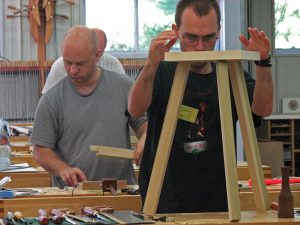We may receive a commission when you use our affiliate links. However, this does not impact our recommendations.
Back when I made my living as a cabinetmaker, the projects I enjoyed most were the ones where we went out on a limb and built something we had never made before. It’s like riding a good roller coaster: scary after you make the decision, walk through the turnstiles, and crawl up the first hill; thrilling as you go down the big hill and into the curves; and satisfying when you’re done. The biggest asset a woodworker can have is the ability to problem solve – to figure out ways to put things together with the tools you have. This involves the risk of putting yourself to the test, trying a new technique or stretching a skill you’re comfortable with on a task outside your comfort zone.
These challenging projects take you to a new level and make basic work easier and more efficient. If you can hand cut a tenon shoulder at a compound angle, square shoulders are no longer a big deal. If you can make one through-tenon joint, why not see if you can make three come together in a triangle? If you can see how the high spot in the seat joint can throw off the fit in the stretchers, there aren’t many problems that are beyond your abilities to solve.
Most of the challenges in woodworking can eventually be reduced to cutting to a line. In some projects, the hard part is deciding where the line really is and making the leap of faith to go ahead and cut it. One of my all-time favorite projects is the three-legged stool I made for the cover of the Winter 2009 issue of Woodworking Magazine. When I was building the project for the article, I kept thinking it would be a great project for a hands-on class, it’s a nice-looking and functional piece when you’re done, and it does some interesting things to your brain while you’re working on it. Last weekend, a group of woodworkers joined me at the Marc Adams School of Woodworking to see if I was right. I still enjoy going out on a limb, and as I prepped the stock for the class I decided to bring enough material for each student to make two stools. I wasn’t expecting anybody to build two, I was seeking insurance in case things went horribly wrong.
In the end, we didn’t need any of the extra parts. Each of the students managed to do something that neither I nor Contributing Editor Chris Schwarz managed to do: they got through the joinery without getting parts turned around and having a dumb-a$$ attack. They stretched their thinking and entered into a world where nothing is square and the reference for everything is an imaginary line in space. They left with one stool done (or mostly done) and the parts to make another. They also left with some practical methods to use that will let them go out on a limb and build something they’ve never done before. They’re now close to having the attitude of “if I can’t make it, you don’t need it.”
Here are some supplies and tools we find essential in our everyday work around the shop. We may receive a commission from sales referred by our links; however, we have carefully selected these products for their usefulness and quality.











Just reading the article and looking at the stool on the cover made my head spin a little bit. It is on my list of projects to work towards.
Always nice to see an adventurous & unique perspective 😀 Love the post, definitely pushing people to expand their edge!
I like reading your articles and essays. This little piece is the reason I think you should be named to replace Chris as Editor … if you want it. I also think that you may be just a bit independent minded for some suits’ taste … and all the more power to you.
This was a wonderfull
class and week end. It was a new lesson on building off a point in space rather than a point on the piece. It was also a perfect lesson on a layout drawing to provide angles and measurements rather than building to a specification in a plan.